"Good Enough" Photography
Long ago, I was a professional photographer. Until last summer, I hadn't photographed a wedding for at least 15 years, but my older daughter's oldest friend asked if I would photograph her wedding. How could I refuse? Things have changed. Digital photography makes it possible to produce a better product. Professional photographers help you remember important events such as weddings and I certainly recommend hiring a professional. But when it comes to the day-to-day pictures that will mean so much to your children 30 or 50 years from now, those are your responsibility. Sometimes we don't need perfection; sometimes all we need is good enough.
It doesn't take an expensive camera, either. Normally, I'll shoot with my digital SLR because it gives me the control I want and high-quality image files that I can work with. In late November, I joined some co-workers at a Habitat for Humanity job site. I was swinging a hammer, raising walls, and lugging shingles all day. I wanted to take pictures, but I didn't want to take the dSLR along for two reasons: First, my primary job was carpentry and the camera would just get in the way; and second, it would be easy to damage the camera because my primary focus would be on construction. So I took a little $100 point-and-shoot digital camera.
The pictures I brought back were "good enough". The camera is advertised as a 10 megapixel device, but this is clearly a bit of hyperbole on the part of the camera manufacturer. Olympus says the images are 10 Mpxl images because they're interpolated to that size. The sensor clearly creates a much smaller image. And, to make things worse, even the highest quality JPG image (the only file format the camera knows) still leaves a lot of artifacting. So the best I'll get from the camera is mediocre quality.
Click any of the images for a full-size view.
 Our eyes are fairly forgiving when it comes to image quality. Printed at snapshot size, the color fringing in this image would probably not be visible. When viewed at full size, it's quite visible, though, even if many people wouldn't notice it. The fringe effect that occurs at transition points in the image is the result of a relatively inexpensive lens, the quality of the sensor in the inexpensive camera, and the algorithm used to expand the image to 10 megapixels while keeping the file size under control. As a professional, I would never accept this quality.
Our eyes are fairly forgiving when it comes to image quality. Printed at snapshot size, the color fringing in this image would probably not be visible. When viewed at full size, it's quite visible, though, even if many people wouldn't notice it. The fringe effect that occurs at transition points in the image is the result of a relatively inexpensive lens, the quality of the sensor in the inexpensive camera, and the algorithm used to expand the image to 10 megapixels while keeping the file size under control. As a professional, I would never accept this quality.
But as a guy working on a construction site, I found it to be "good enough". The same might be true for family snapshots taken around the house. After all, what's better: A less-than-optimal picture or no picture?
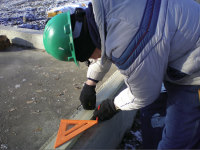 So during my day as a construction worker, I occasionally took a short break to pull the camera out of my jacket pocket aim it at a co-worker, and grab a quick image. I tried to frame the images reasonably well, but when I uploaded the images to my computer, I found that most of them could use a little help. The picture at the right is an example. It's OK, but it could be better with a little color correction and tighter cropping.
So during my day as a construction worker, I occasionally took a short break to pull the camera out of my jacket pocket aim it at a co-worker, and grab a quick image. I tried to frame the images reasonably well, but when I uploaded the images to my computer, I found that most of them could use a little help. The picture at the right is an example. It's OK, but it could be better with a little color correction and tighter cropping.
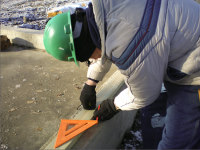 The first problem I tackled was removing some of the excess blue. The difference (left) is fairly subtle, but it's visible.
The first problem I tackled was removing some of the excess blue. The difference (left) is fairly subtle, but it's visible.
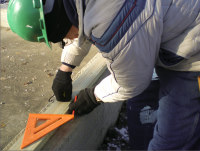 Then I tried cropping, but this (right) was too tight and too low. Because I was using Adobe Lightroom 2, the crop wasn't destructive and I was able to try it again (below, left) with a slightly wider view that focuses on the person, but eliminates the distracting background.
Then I tried cropping, but this (right) was too tight and too low. Because I was using Adobe Lightroom 2, the crop wasn't destructive and I was able to try it again (below, left) with a slightly wider view that focuses on the person, but eliminates the distracting background.
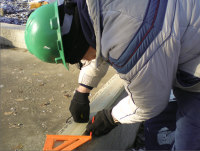 With just a small amount of work, I created a better image from a snapshot camera.
With just a small amount of work, I created a better image from a snapshot camera.
You don't need a professional photographer or an expensive camera to create pictures that you and your family will enjoy decades from now. Even if you don't do any of the enhancement work, you'll be giving your children some important memories that they will cherish.
Honest. Trust me on this one.
Adobe Photoshop CS4: 11th Time is the Charm
Photoshop CS4 is the 11th iteration of Photoshop and the application just keeps getting better. This time around, Adobe spent more time on stability, reliability, ease of use, and the user interface than on developing new features. Even so, there's no shortage of new features.
ALL ARTICLES IN THIS SERIES
I will add links to this sidebar as I complete reviews.
Introduction, Installation, and Bridge
Photoshop
InDesign and InCopy
Dreamweaver
Acrobat
Soundbooth and Audition
Adobe's video applications
Flash and Fireworks
Illustrator
Sometimes a really small feature can provide big advantages. This is one of those: Tabs. Remember when browsers didn't have tabs? Now they all do and the benefits tabs provide is clear to anyone who has ever tried to have more than one website open at a time. The same is true for Photoshop; the tabs improve usability.
On the other hand, I'm not yet entirely certain that I like the Masks & Adjustments Panel. Although I suspect that this feature will grow on me just as Microsoft's ribbon interface in Office 2007 did, right now it seems to take too much space on the interface. Adobe's goal was to provide quick, easy access to common masking tools for both pixel and vector-based masks.
Only a year or two ago, I watched a presentation that showed an adjustment tool that would allow a user to fit an image to a specific format without distortion. I watched as a square image morphed into a horizontal image without stretching important components of the image. It was all experimental then. Now it's in Photoshop under "Edit, Content Aware Scale". You need to tell Photoshop which parts of the image need to be protected. If you've ever had an image that won't fit the space allocated for it and can't be cropped, you'll understand just how important and ground-breaking this feature is.
Click any of the images for a full-size view.
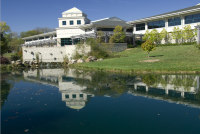 Because I'm a cantankerous old coot, I thought I'd throw an uncommonly difficult image at Photoshop's content-aware scaling. The image at the right, for example, has a white building from near the left edge of the image to the upper right corner. All of the building should be protected if one wants to avoid obvious distortion.
Because I'm a cantankerous old coot, I thought I'd throw an uncommonly difficult image at Photoshop's content-aware scaling. The image at the right, for example, has a white building from near the left edge of the image to the upper right corner. All of the building should be protected if one wants to avoid obvious distortion.
 < The best option in this case would be simply to crop the image to square if that's what I needed for a publication. This works, but what if we still need to see the wing at the right?
< The best option in this case would be simply to crop the image to square if that's what I needed for a publication. This works, but what if we still need to see the wing at the right?
This, by the way, is at Coffman Park in Dublin.
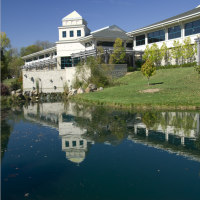 < So I tried just squishing the image. Surprisingly, this wasn't as bad as I thought it would be. But look how thin the tower is now. And the square windows are no longer square.
< So I tried just squishing the image. Surprisingly, this wasn't as bad as I thought it would be. But look how thin the tower is now. And the square windows are no longer square.
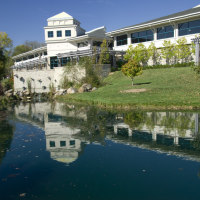 < My next attempt allowed Photoshop to decide on its own what to compress and what to lave alone. The roof line on the left has become a bit wavy, but overall the result is surprisingly good. And someone who knows what the tower is supposed to look like won't write to tell me that I've squished it.
< My next attempt allowed Photoshop to decide on its own what to compress and what to lave alone. The roof line on the left has become a bit wavy, but overall the result is surprisingly good. And someone who knows what the tower is supposed to look like won't write to tell me that I've squished it.
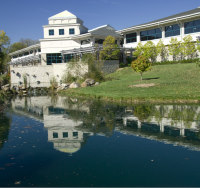 < This time, I masked the tower and the small tree in the foreground. This tells Photoshop to leave these areas alone. The left wing of the building is foreshortened quite a bit and the right wing is compressed, but the tower is essentially untouched.
< This time, I masked the tower and the small tree in the foreground. This tells Photoshop to leave these areas alone. The left wing of the building is foreshortened quite a bit and the right wing is compressed, but the tower is essentially untouched.
Image modifications such as this, while not ideal, can save the day when you're faced with inserting a rectangular image into a square hole, or vice versa.
Depth of Focus
To help reviewers, Adobe and other software companies provide files that can be used to illustrate an application's new features. As much as I appreciate having those files, I rarely use them in a review because they are usually designed to show off an application's new features in the most favorable light. For example, Adobe would be unlikely to provide an image such as the one I used to show content-aware scaling. Adobe would be most likely to provide an image with one or two main object surrounded by large open spaces. I prefer to give the program something a bit more challenging to work with. To illustrate the new depth-of-focus magic, I'll use files provided by Adobe.
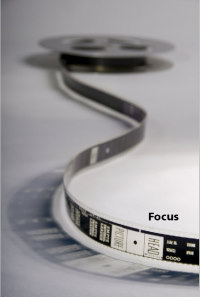
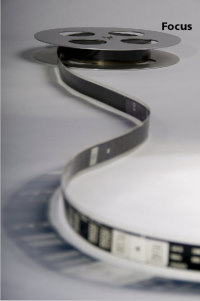 Here's a common problem: You're photographing something small on a table top. No matter how much you stop the lens down, some of the image is out of focus. You don't have a view camera with swings and tilts, so there's no way that you can create the extended depth of focus that you want. Or is there?
Here's a common problem: You're photographing something small on a table top. No matter how much you stop the lens down, some of the image is out of focus. You don't have a view camera with swings and tilts, so there's no way that you can create the extended depth of focus that you want. Or is there?
The images on the left and right have a shallow depth of field. On the left, the point of focus is near the front of the image. On the right, the focus is near the back. Adobe provided a total of 10 images, these and 8 more with focus at various points along the strip of film.
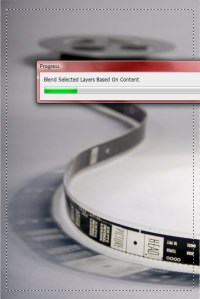
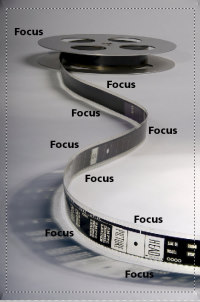 With Photoshop CS4, this is an easy fix. All I need to do is open the images in Bridge, select all of them, and load them into Photoshop "as layers". Then, I select all of the images in the Layers panel and choose Edit, Auto-Align Layers to make sure that all of the layers are aligned correctly even if I didn't use a tripod to ensure alignment. The next step is to "Auto-Blend" the layers with the method set to "Stack Images" and the "Seamless Tones and Colors" option enabled. Done. Yes, it's that easy.
With Photoshop CS4, this is an easy fix. All I need to do is open the images in Bridge, select all of them, and load them into Photoshop "as layers". Then, I select all of the images in the Layers panel and choose Edit, Auto-Align Layers to make sure that all of the layers are aligned correctly even if I didn't use a tripod to ensure alignment. The next step is to "Auto-Blend" the layers with the method set to "Stack Images" and the "Seamless Tones and Colors" option enabled. Done. Yes, it's that easy.
The result is the image on the right and, as you can see, the image is in focus from the front to the back.
This is one extremely cool feature!
Throwing Photoshop a Curve Ball
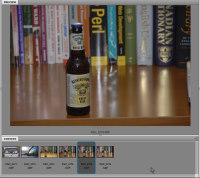
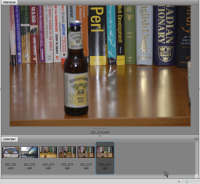 Then I thought I'd give Photoshop an unfair challenge. I would set up a scene with a foreground object and a background object, use a hand-held camera to capture 2 images (one focused at the front and the other at the back), and then see how bad the results would be. The close-focus image is on the left, the far-focus image on the right. In the image at the right, note the soft-focus glow around the bottle cap.
Then I thought I'd give Photoshop an unfair challenge. I would set up a scene with a foreground object and a background object, use a hand-held camera to capture 2 images (one focused at the front and the other at the back), and then see how bad the results would be. The close-focus image is on the left, the far-focus image on the right. In the image at the right, note the soft-focus glow around the bottle cap.
The images Adobe provided worked so well because Photoshop had so many to work with. My reason for using just 2 images was to see if I could break the process. The first two images in the series were tests and were not used in creating the merged photo.
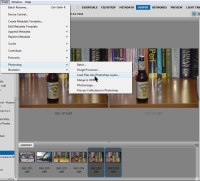
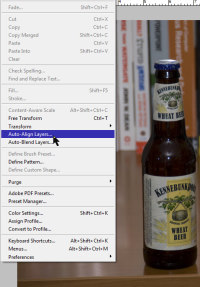 The next step was to select the 2 images in Bridge and send them to Photoshop as layers of a single image file.
The next step was to select the 2 images in Bridge and send them to Photoshop as layers of a single image file.
Once the images were inside Photoshop, only 2 simple steps remained. First, on the right, auto-aligning the layers. This is particularly important because I created the images without benefit of a tripod. My alignment was close, but not close enough to skip this step.
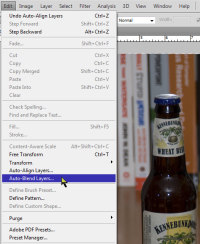 Now that the photos are aligned, I'll use the auto-stack function. Photoshop considered the task for a few seconds and then returned the merged image.
Now that the photos are aligned, I'll use the auto-stack function. Photoshop considered the task for a few seconds and then returned the merged image.
I was disappointed. The image was nearly perfect. The test I had devised to trip up Photoshop hadn't worked.
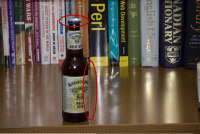 Click the image at the right to enlarge it and take a look at the bottle cap and at the right edge of the label. There's enough fuzziness and blooming to let you know that this is a merge job, but considering what the program had to work with, the results are phenomenal.
Click the image at the right to enlarge it and take a look at the bottle cap and at the right edge of the label. There's enough fuzziness and blooming to let you know that this is a merge job, but considering what the program had to work with, the results are phenomenal.
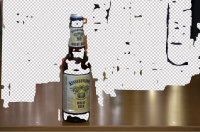
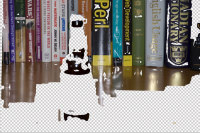 These images show the alpha masking. In some cases, Photoshop selected what might be considered to be the wrong parts of an image, but the resulting merged image looked right.
These images show the alpha masking. In some cases, Photoshop selected what might be considered to be the wrong parts of an image, but the resulting merged image looked right.
If you'd like to see the full-size image as a high quality JPG, click the image below and the larger image will open on your screen.
 The image is about 1.1MB. So far, my attempts to break Photoshop haven't been working out very well.
The image is about 1.1MB. So far, my attempts to break Photoshop haven't been working out very well.
Software Depends on Hardware
 Photoshop CS4 supports astonishingly large files, but only for Windows Vista 64-bit system users. This feature will be available to Mac users when Apple releases a 64-bit version of OS X. Photoshop CS4 also supports 3D acceleration via OpenGL compatible graphics cards, so you'll see faster performance with 3D operations. But if you have an older video card (mine is about 24 months old, a veritable antique by today's standards, but it has the most recent drivers loaded) you may occasionally see error messages.
Photoshop CS4 supports astonishingly large files, but only for Windows Vista 64-bit system users. This feature will be available to Mac users when Apple releases a 64-bit version of OS X. Photoshop CS4 also supports 3D acceleration via OpenGL compatible graphics cards, so you'll see faster performance with 3D operations. But if you have an older video card (mine is about 24 months old, a veritable antique by today's standards, but it has the most recent drivers loaded) you may occasionally see error messages.
 Bottom line: If you skipped Photoshop CS3, don't skip CS4.
Bottom line: If you skipped Photoshop CS3, don't skip CS4.
In dealing with computers, it's important to keep 2 concepts firmly in view: First, software is nothing more than a string of zeros and ones; second, Arthur C. Clarke's maxim, which stated that any sufficiently advanced technology is indistinguishable from magic. Photoshop, although it's nothing more than zeros and ones, increasingly makes me want to believe in magic.
For more information, visit the Adobe website.
Nerdly News
Vista Turns 2—Did You Send a Card?
I gave Vista a present this year: I removed it from my computer. After two years of wishing and hoping that Microsoft would make Vista work, I have officially given up on it. I once said that Vista was inevitable. That was wrong. If someone like me—someone who wants to make it work and someone who likes large parts of it—has given up on Vista, what can the future be for what increasing numbers of people are referring to as "Me II"?
"Me", of course, was the name for Microsoft's much maligned (and rightly so) "Millennium Edition". Even Microsoft admitted that Me was probably their worst operating system ever. Vista doesn't even approach Me when it comes to being poorly designed, but it certainly doesn't work the way it was supposed to. And the fact that Microsoft colluded with hardware manufacturers to allow "Vista ready" stickers to be placed on hardware that clearly wasn't even remotely ready for Vista didn't help with perception of the operating system.
Vista's second birthday went all but unnoticed at Microsoft. The company seems to be hoping that people will just hang on—with XP or Vista—until the next version of Windows is released. It's on a hurry-up schedule, but it it won't see the light of day until late in 2009. And, if Microsoft's past performance is any guide, it might not be until 2027. (Yes, I am employing a bit of hyperbole there. But I'll be surprised if Microsoft ships Windows 7 before 2010.)
Gartner research says that 90% of businesses are sticking with XP (or Windows 2000) and only about 10% have moved to Vista. Most of those businesses are now planning to wait for Windows 7. The next version is based on Vista, of course, but this time Microsoft says they'll get it right. They'll demand that development teams work together.
You've probably been able to tell from my writing about Vista over the past 2 years that I liked it. Then I disliked it. Then I liked it again. In the end, frustration was setting in when a problem set it motion the changes that caused me to "upgrade" from Vista to XP. I'll tell you about that next week.
Vista, it seems, will join the ranks of other Microsoft failures: My Vista disc will go to live with Microsoft Bob and Microsoft Windows Me. But Vista will be back, reloaded.
EWeek Calls Ubuntu the "Best Linux Distribution for Desktops"
In an EWeek report, Jason Brooks writes "The latest version of Canonical’s Linux distribution, Ubuntu 8.10, still outshines the Linux desktop offerings from Red Hat and Novell, and is the best open-source alternative to Microsoft and Apple operating systems." The report goes on to say that Ubuntu is behind the pack when it comes to running servers. I'm more interested in what happens on the desktop and I had just set up my desktop computer as a dual-boot system with Windows XP and Ubuntu Linux.
Ubuntu Linux 8.10 is the latest release. The 8 means it was released in 2008 and 10 indicates October. Canonical always gives each version a name. Unlike Apple, which names all of its operating systems after cats, Canonical chooses from a variety of animals. "Hardy Heron" was the previous version. This time around it's "Intrepid Ibex".
 That's a Ibex over there at the right (click for a larger view).
That's a Ibex over there at the right (click for a larger view).
Canonical continues to make an operating system that's capable of competing on the desktop, space that has largely been owned by Microsoft and, to a much lesser extent, Apple. One of Ubuntu's primary advantages, at least the way I see it, is the ease with which a user with no Linux experience can install and maintain the applications that run on Linux, whether they're maintained by Canonical, by the Linux community at large, or by commercial developers such as hardware manufacturers who make drivers available for Linux.
As Brooks put it, "[W]hile most Linux distributions come with the same software components, Ubuntu distinguishes itself with its attention to usability, its large selection of ready-to-install software packages, and its large community of users and contributors."
To read the full report by Jason Brooks, visit the EWeek website.
The Weekly Podcast
Podcasts are usually in place no later than 9am (Eastern time) on the date of the program. The podcast that corresponds to this program is below. The most recent complete podcast is always located here.
Search this site: Looking for something you remember hearing about on TechByter Worldwide? Search me.
Subscribe to the newsletter: Subscribing to the podcast: I recommend Apple's Itunes for podcasts. Itunes will also install the latest version of QuickTime. The program is free. Need instructions?
Privacy Guarantee: I will not sell, rent, loan, auction, trade, or do anything else with your e-mail address. Period.
How the cat rating scale works.
Do you use a pop-up blocker? If so, please read this.
The author's image: It's that photo over at the right. This explains why TechByter Worldwide was never on television, doesn't it?
Feed the kitty: That's one of them on the left. Creating the information for each week's TechByter requires many hours of unpaid work. If you find the information helpful, please consider a contribution. (Think "NPR".)


